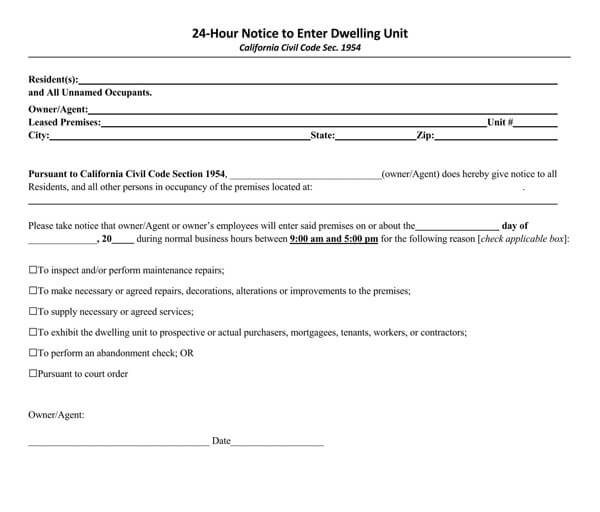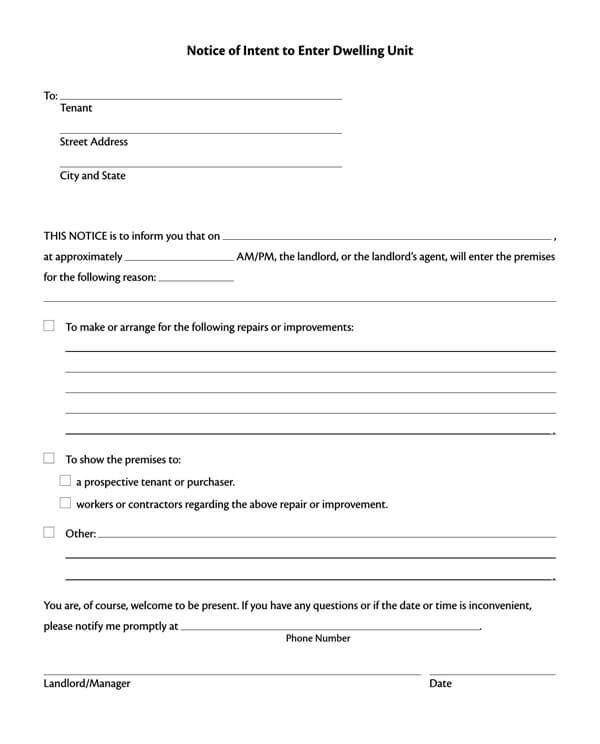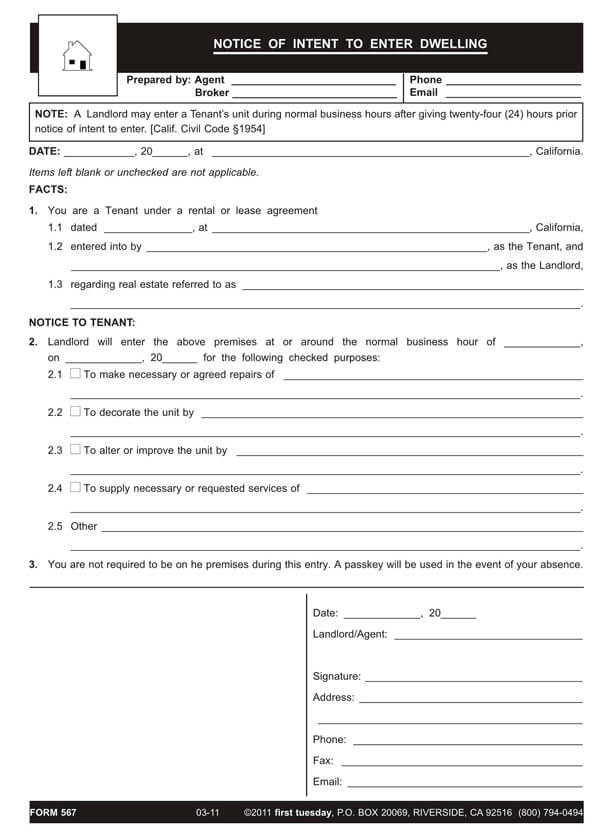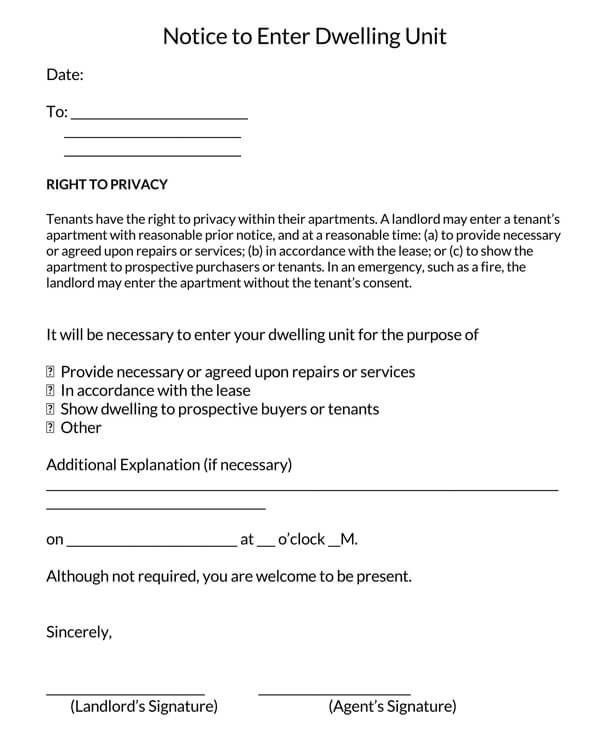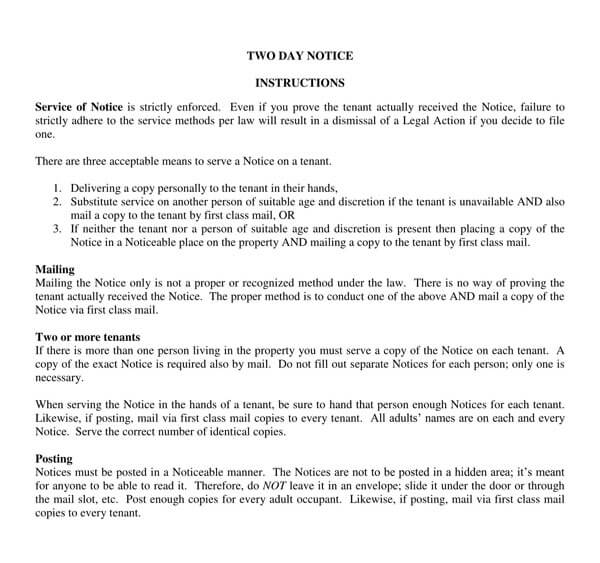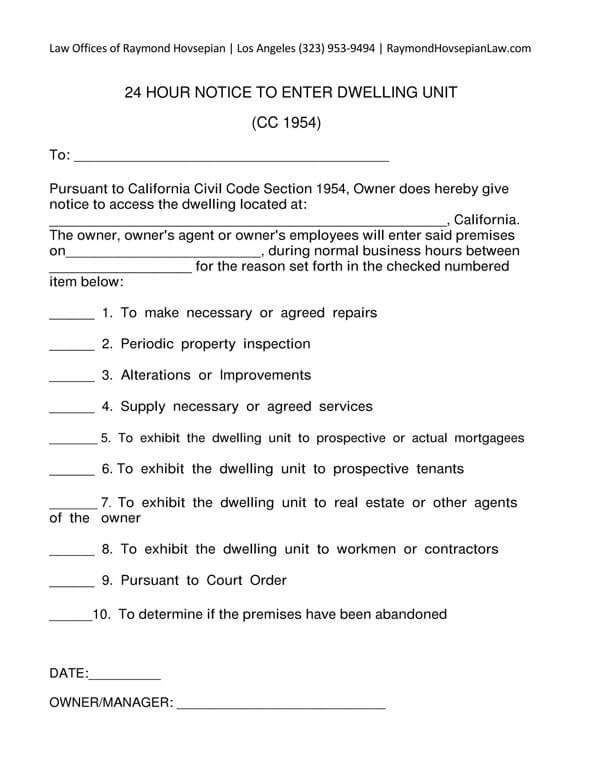A Notice to Enter Dwelling is a formal notice that a property manager or landlord gives to the tenant of a rental property before entering the rental property on a particular date and time. Notice to Enter serves as both a courtesy and a legal requirement that recognizes the rights of both landlords and tenants.
There are only specific reasons why a landlord can give a notice of entry. These reasons include:
- Inspecting the condition of the premises;
- To make repairs;
- Controlling pests to ensure a healthy environment;
- If the landlord or tenant has terminated the periodic tenancy, it is okay to show the premises to potential tenants during the last month of the lease.
- For following any legal court order
- For inspecting a property unit according to the California Civil Code 1950. 5 (f). The local laws may vary according to the state.
While sending the notice, a landlord should consider that legally he is allowed only to send one notice in a month.
Types of Notice to Enter Dwelling Unit
For entering a dwelling unit, there are two types of notices. Both types vary depending on how long before the landlord or the manager sends the notice for visiting the tenant’s residence.
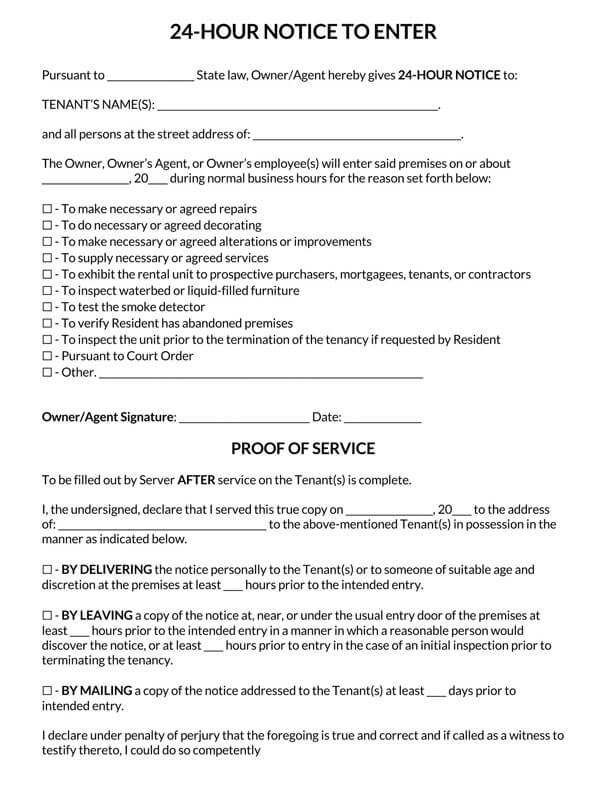
24 Hour Notice to Enter Dwelling Unit
A landlord should use this type of notice if they intend to notify the tenant at least 24 hours before entry. Typically, this notice form is used by a landlord to perform minor maintenance and repairs on the property or inspect the property for safety and security reasons. In most US states, landlords have to send the Notice to enter the dwelling unit 24 hours before visiting the residence.
Download: Microsoft Word (.docx)
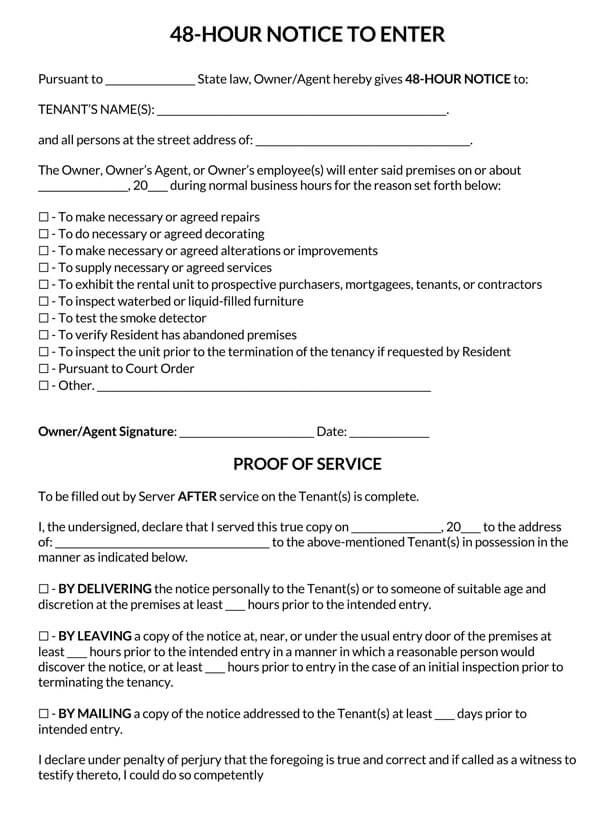
48-Hour Notice to Enter Dwelling Unit
As the name suggests, this type of notice is used if landlords intend to notify the tenant 48 hours prior to the visit to the residence. Landlords mostly use this form for two reasons: legal property inspections and to showcase their properties to potential tenants and buyers, which is why the current tenant needs to make sure his apartment is clean, well-arranged, and safe if he will not be in attendance.
Download: Microsoft Word (.docx)
Notice by State
Notice Requirements
The Notice to Enter Dwelling fulfills the landlord’s requirement to notify the tenants when the landlord intends to enter the occupied space. However, there are some other requirements in the state of california according to the California Department of Consumer Affairs, and the California Civil Code that the property owner has to fulfill, which include:
- The Notice to Enter Dwelling must be in writing.
- A landlord must clearly state the reason for entering the premises in the Notice to Enter Dwelling.
- The landlord can only enter the unit between 8:00 a.m. and 8:00 p.m.
- The tenant cannot be given Notice to Enter Dwelling for more than two days. For instance, the notice cannot specify that the landlord intends to enter between Monday and Saturday. It is the landlord’s responsibility to provide a specific entry date and time.
- Before entering the premises, the tenant must be given a written notice 24 hours in advance.
It is the landlord’s responsibility to give the tenant notice of entry personally by certified mail. If none of these methods are successful, the landlord can give the notice to another adult in the unit or post the notice in plain sight on the premises. However, if none of these methods prove successful, the landlord has the option to send the notice electronically, but in that case, it has to be sent 6 days before the visit.
In most states, particular laws restrict tenants from entering the dwelling unit without the written notice and permission of the tenant, and there is a penalty for going against it. For example, in California, according to the California Civil Code of 1940, landlords are prohibited from abusing an eviction notice or entering the dwelling unit to harass the tenants or infringe on their privacy. Any such act will be considered trespassing, and the court will prosecute the individual accordingly.
Moreover, forcing the tenant(s) to vacate the unit will also be considered a violation of the California Civil Code 1954. Under California Civil Code 1940, a landlord could be fined up to $2,000, under privacy laws, if they invade the tenant’s privacy or consent. The amount of fine can vary according to the local laws.
Situations in which Notice is not Required
Typically, a notice is necessary to enter a dwelling unit, but the following are some situations when the notice is not required:
- The landlord does not have to give a Notice to Enter Dwelling if there is an emergency. For example, if the landlord sees smoke and thinks the property is on fire, he can enter the property without notifying the tenants.
- A landlord does not have to give notice if the tenant consents to the landlord entering. The tenant could, for instance, email the landlord to arrange for repairs and give the landlord permission to have someone come to the unit on a particular day.
- The landlord does not need to give the Notice to Enter Dwelling if the tenant has abandoned the premises. In the case where the landlord has not heard from a tenant for more than two months, doesn’t receive rent, and when approached by the tenant’s employer finds out the tenant no longer works there, the landlord may have grounds to consider the property abandoned.
How to Write Notice to Enter Dwelling Unit
The Notice to Enter Dwelling unit must be written formally and should follow legal writing requirements. It must also include personal details, address, and a signature.
Personal Information
A Notice to the tenant must include the personal information of the landlord or the leasing agent, such as their legal names, contact details, and addresses for the purpose of keeping records.
Premises Address
The landlord must mention the address of the property including the name of state, city, street name, and zip code to avoid any legal issues or disputes.
Date to enter the dwelling
As mentioned earlier, the landlord must clearly mention the day, date, and timing for entering the dwelling in the notice to notify the tenant. Not clearly mentioning the date can result in a conflict which can lead to the landlord getting fined by the local authorities.
Reason for entering
The landlord may enter the tenant’s dwelling unit for a variety of reasons. Each of these reasons should be listed with a checkbox next to it so that the landlord can indicate his reason.
Date of the Notice
The date on the notice indicates the day on which the notice is being sent to the tenant.
Signatures
The signatures of the landlord or the leasing agent who sent the notice should be collected on the form for legal purposes.
Proof of service document
Proof of service document verifies that the landlord has attempted to deliver the notice to the tenant, and it is a legal necessity to use it along with the notice to enter dwelling unit form.
Free Notice Templates
Required Notice Periods
In the United States, lease agreements are governed by the state’s laws in which they are executed, and the Notice to Enter must comply with those laws. In general, individual state laws govern the required notice period a landlord must give the tenant for entry and sometimes for what reasons a landlord may enter.
| State | Statute |
|---|---|
| Alabama | § 35-9A-303 |
| Alaska | § 34.03.140 |
| Arizona | ARS 33-1343 |
| Arkansas | No statute |
| California | CIV § 1954 |
| Colorado | No statute |
| Connecticut | § 47a-16 |
| Delaware | Title 25 § 5509 |
| Florida | § 83.53 |
| Georgia | No statute |
| Hawaii | § 521-53 |
| Idaho | No statute |
| Illinois | No statute |
| Indiana | § 32-31-5-6 |
| Iowa | § 562A.19 |
| Kansas | § 58-2557 |
| Kentucky | § 383.585 |
| Louisiana | No statute |
| Maine | § 6025 |
| Maryland | No statute |
| Massachusetts | No statute |
| Michigan | No statute |
| Minnesota | § 504B.211(Subd. 2) |
| Mississippi | No statute |
| Missouri | No statute |
| Montana | § 70-24-312 |
| Nebraska | § 76-1423 |
| Nevada | NRS 118A.330 |
| New Hampshire | RSA 540-A:3 |
| New Jersey | NJSA 2A:39-1, § 5:10-5.10 |
| New Mexico | § 47-8-24, § 47-8-34 |
| New York | Residential Tenants’ Rights Guide (page 54) |
| North Carolina | No statute |
| North Dakota | § 47-16-07.3 |
| Ohio | § 5321.04, §5321.05(B) |
| Oklahoma | § 41-128 |
| Oregon | § 90.322 |
| Pennsylvania | No statute |
| Rhode Island | § 34-18-26, §34-18-39 |
| South Carolina | § 27-40-530, §27-40-720, §27-40-730 |
| South Dakota | No statute |
| Tennessee | § 66-28 |
| Texas | No statute |
| Utah | § 57-22-4, § 57-22-5(2)(c) |
| Vermont | § 4460 |
| Virginia | § 1229, § 1248, § 1249 |
| Washington | § 59.18.150 |
| Washington D.C. | § 8–231.06(a) |
| West Virginia | No statute |
| Wisconsin | §704.05(2), ATCP 134.09 |
| Wyoming | No statute |
FAQs
What can you do if the tenant doesn’t allow viewings?
If the tenant does not allow the landlord to see the property without a valid reason, he has the right to take legal action against him.
Can the landlord enter the property whenever they want?
No, a landlord cannot enter the property whenever they want such as on holidays. They must give prior notice, and only then can they enter the property.
How can the Notice to enter the dwelling unit be delivered?
The notice to enter a dwelling unit can be delivered by hand, mail, or electronically. The landlord must make sure that tenant receives the Notice.
